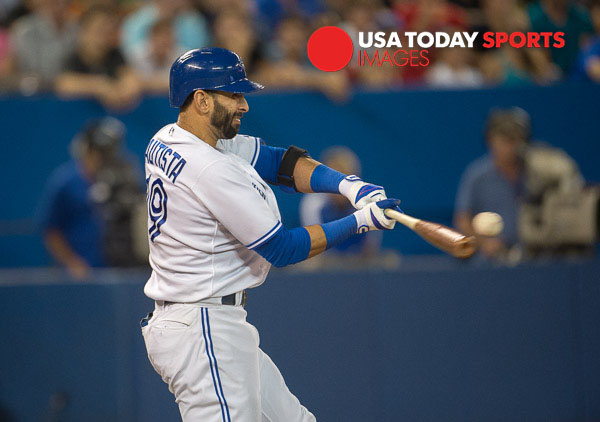Many years ago, long before we ever came to live in North America, my wife Jean and I were sitting in a restaurant in Houston Texas having a meal while en-route to cover another major sports event. A nearby TV was showing the baseball play-offs games and it was evident that tour waiter was more intent on the game than on serving us. To get his attention we decided that the best course of action was to engage him in a conversation about the game as frankly, we had no idea what was going on. There followed a series of questions around the rules of the game, distance from pitcher to batter, how far it was around the bases, how many players in a team which, if achieving little else, did get us our meal served.
Fast forward to 2014 and I found myself in Toronto working as the Photo Chief for the 2015 PanAm Games. So, I started to pick up some photo assignments, mostly for USA Today, covering major pro-sports event in and around the city. Inevitably, I therefore picked up my first assignment to shoot baseball, and quickly realized that little I had learned all those years ago had stayed with me.
My first ever game was Canada Day, July 1st 2014, a national holiday here in Canada.
 I had tried to study other photographers photos, including the work of some famous baseball photographers including Brad Mangin and Robert Beck to try and figure out the shooting angles and chatted to friends here in Toronto to get the names of the teams leading photographers. So far all well and good!
I had tried to study other photographers photos, including the work of some famous baseball photographers including Brad Mangin and Robert Beck to try and figure out the shooting angles and chatted to friends here in Toronto to get the names of the teams leading photographers. So far all well and good!
I have always believed that a good sports photographer can go to any new sport and quickly figure out the best ways to shoot it, and found that baseball is easily learned – up to a point. Sure there are the photos of the pitcher throwing the ball, and the batter hitting the ball but much of the best action photos come from other plays, sliding to a base, fielders catching and I soon found that my lens was pointing one way while all the others were in an entirely different direction as they were anticipating plays – still a lot to learn. And one other thing, I realized that, although I thought my reflexes were pretty good, not one of my batting pictures had the ball in.

My first ever photo of a player diving to the plate. Jul 1, 2014; Toronto, Ontario, CAN; Milwaukee Brewers Left Field Khris Davis dives to make first base watched by Blue Jays First Baseman Credit: Peter Llewellyn-USA TODAY Sports
Nikon D3s, Nikon 200-400mm f4 lens at 250mm 1250th @f4, ISO 800, set manually, Gitzo carbon fibre monopod
Now, shooting for a major wire service like USA Today Sports Images means that you are constantly having to decide when it is a suitable break in play to race in to the photo area, select some images, caption them, transmit them and get back out again hoping you didn’t miss any major play. And thereby came the next problem. In most sports I was used to very simple captioning – i.e. Seve Ballesteros (ESP) putts on the 18th green to win the British open golf, or Rafael Nadal plays a forehand in round two at Wimbledon, and so, adopted the same principal for captioning my baseball photos. Big mistake!

May 10, 2015; Toronto, Ontario, CAN; Boston Red Sox second base Dustin Pedroia (15) turns a double play as Toronto Blue Jays designated hitter Jose Bautista (19) slides to seconds base in eighth inning at Rogers Centre. Red Sox beat Blue Jays 6 – 3 Mandatory Credit: Peter Llewellyn-USA TODAY Sports
Nikon D3, Nikon 200-400mm f4 lens at 360mm 1000th @f4, ISO 3200, set manually, Gitzo carbon fibre monopod
Phone starts ringing from the editors desk asking me what the play was – i.e. was that the RBI single from the pinch hitter in the 7th inning? Of course I had no idea what he was talking about, and what’s a pinch hitter anyway? Fortunately I had colleagues in the TO2015 office who were baseball fans, and the other photographers at the game soon started to educate me in the finer points of the game and before long my images started to improve, and the caption errors got less.
![September 2 2015: Toronto Blue Jays Designated hitter Edwin Encarnacion (10) [4352] batting against Cleveland Indians in the second inning at Rogers Centre in Toronto, ON, Canada.](https://peterllewellyn.com/blog.peterllewellyn.com/wp-content/uploads/PL_2015-09-02_0827002-e1450413569688.jpg)
September 2 2015: Toronto Blue Jays Designated hitter Edwin Encarnacion (10) [4352] batting against Cleveland Indians in the second inning at Rogers Centre in Toronto, ON, Canada. – Photo Peter Llewellyn Nikon D3, 300 f2.8 lens, 1/1600th @ f2.8, ISO 2000
Oh, and every caption for the play-off games I have covered was absolutely perfect, mainly because we were hard-wiring (plugging an ethernet cable directly into the port on a Nikon D4s and transmitting straight from the camera to the picture editor) the camera to send images and all the post-processing work and captioning was done by the editor. Yes, baseball play-offs are a really big deal. USA Today Sports Images had three photographers at the games, one shooting from an elevated position, one from the photo pit near first base, and yours truly from the photo pit near third base. You cannot afford to miss a big play at this level.
How to improve your baseball photography
These principals apply whether you are shooting your son or daughter at Little League or getting your first opportunity at shooting a big league game.
- Get close to the action – use a long lens and fill the frame as best you can. At least a 200mm even for those school diamonds. I rarely shoot with any less than a 300mm and often am right out to the 500 or 600mm if I want to get good facial expressions
-

Jose Bautista (19) against Boston Red Sox at Rogers Centre. Mandatory Credit: Peter Llewellyn-USA TODAY Sports Nikon D4s, 500mm f4 lens, 1/1600th @ f4, ISO 3200
Use a fast shutter speed to stop the action, especially if you are trying to get the ball in the picture. 1,000th second at an absolute minimum and even at that speed you will still probably get a slightly blurred ball. Remember, that with any modern DSLR you can push the limits by increasing the ISO setting. I often use the auto ISO setting on my Nikons where I can ensure that if the light drops to a level that would make the shutter speed less than 1,000th the ISO will automatically increase to compensate.
- If you see the ball in the viewfinder it is probably not going to be in the picture you take, especially as you get to the bigger league games with faster pitchers and harder hitting batters. By the time your brain tells your finger to press the shutter, and the mechanics of the camera operate to open the shutter the ball is either in the catchers glove or sailing over the outfield. At MLB games I keep both eyes open and try to watch the ball leaving the pitchers hand, press the shutter and fire a sequence of two or three and you are likely to get the ball in the frame – with a bit of luck actually connecting with the bat
-

Aug 23, 2014; Toronto, Ontario, CAN; Toronto Blue Jays Melky Cabrera (53) slides in make second base while Tampa Bay Rays second base Logan Forsythe (10) catches in ninth innings at Rogers Centre – Mandatory Credit: Peter Llewellyn-USA TODAY Sports. Nikon D3s, 200-400 f4 lens at 260mm, 1/2500th @f4, ISO 1000
Anticipate the action – not all good action shots are pitchers or batters at the plate. Watch when players are on the bases, stolen bases or the batter diving to home plate make some of the greatest action shots. Concentrate, focus on the player and follow focus the action if your camera focusses fast enough or pre-focus on the point where you expect the action be if your camera is a little slow. Almost any modern DSLR will allow you to follow the action. However, even with he fastest cameras, make sure you have your focussing set up properly. My cameras allow 51 points of focus but for any sport where you are essentially focussing on a single player cut this number down in your menu settings and your success rate will improve dramatically. I always use 9 focus points on my Nikons for this type of sport.
- If you have a favourite player (your son or daughter!) make sure you shoot from the right side of the field. A right handed pitcher should be shot from

May 4, 2015; Toronto, Ontario, CAN; New York Yankees opening pitcher Chase Whitley (39) pitches in first inning against Toronto Blue Jays at Rogers Centre. Mandatory Credit: Peter Llewellyn-USA TODAY Sports Nikon D3, 500mm f4 lens, 1/100th @ f4, ISO 2500
third base, a leftie from first. A right handed batter, go to first and a leftie from third.
I hope you find the tips will help you improve your baseball photography.
UPDATE: Yesterday, 14th October, Toronto Blue Jays won the divisional championships. Take a look at the latest images gallery to see a small selection of some of my favourites or go to http://www.usatodaysportsimages.com to see the full selection



